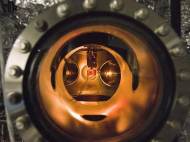Photon Enhanced Thermionic Emission process boosts efficiency of solar panels
 Stanford engineers have found out how to simultaneously use the light and heat of the sun to generate electricity in a way that could make solar power production more than twice as efficient as existing methods and potentially cheap enough to compete with oil. Unlike photovoltaic technology currently used in solar panels (which become less efficient as the temperature rises) the new process excels at higher temperatures.
Stanford engineers have found out how to simultaneously use the light and heat of the sun to generate electricity in a way that could make solar power production more than twice as efficient as existing methods and potentially cheap enough to compete with oil. Unlike photovoltaic technology currently used in solar panels (which become less efficient as the temperature rises) the new process excels at higher temperatures.
“This is really a conceptual breakthrough, a new energy conversion process, not just a new material or a slightly different tweak,” said Nick Melosh, assistant professor of materials science and engineering, who led the research group. “It is actually something fundamentally different about how you can harvest energy.”
Called Photon Enhanced Thermionic Emission (PETE), the process promises to surpass the efficiency of existing photovoltaic and thermal conversion technologies. Most photovoltaic cells, such as those used in rooftop solar panels, use the semiconducting material silicon to convert the energy from photons of light to electricity. But the cells can only use a portion of the light spectrum, with the rest just generating heat.
Melosh’s group figured out how to use that heat by coating a piece of semiconducting material with a thin layer of the metal cesium. It made the material able to use both light and heat to generate electricity. While most silicon solar cells have been rendered inert by the time the temperature reaches 100°C (373.15°K), the PETE device doesn’t hit peak efficiency until it is well over 200°C.
Photovoltaic systems never get hot enough for their waste heat to be useful in thermal energy conversion, but the high temperatures at which PETE performs are perfect for generating usable high-temperature waste heat. Melosh calculates the PETE process can get to 50 percent efficiency or more under solar concentration, but if combined with a thermal conversion cycle, could reach 55 or even 60 percent (almost triple the efficiency of existing systems).
In the “proof of concept” tests the researchers used a gallium nitride semiconductor. The efficiency they achieved in their testing was well below what they have calculated PETE’s potential efficiency could be, but they used gallium nitride because it was the only material that had shown indications of being able to withstand the high temperature range they were interested in and still have the PETE process occur. With the right material (like gallium arsenide which is used in a host of common household electronics) the actual efficiency of the process could reach up to the 50 or 60 percent the researchers have calculated. They are already exploring other materials that might work.
Another advantage of the PETE system is that by using it in solar concentrators, the amount of semiconductor material needed for a device is quite small. Because PETE performs best at temperatures well in excess of what a rooftop solar panel would reach, the devices will work best in solar concentrators such as parabolic dishes, which can get as hot as 800°C. Dishes are used in large solar farms similar to those proposed for the Mojave Desert in Southern California and usually include a thermal conversion mechanism as part of their design, which offers another opportunity for PETE to help generate electricity as well as minimize costs by meshing with existing technology.
“For each device, we are figuring something like a 6-inch wafer of actual material is all that is needed,” Melosh said. “So the material cost in this is not really an issue for us, unlike the way it is for large solar panels of silicon.”
The cost of materials has been one of the limiting factors in the development of the solar power industry, so reducing the amount of investment capital needed to build a solar farm is a big advance. Since the system shows potential to increase efficiency from 20 to 30 percent (or more if the researchers reach their expectations), it could make solar energy competitive with oil.









Leave your response!